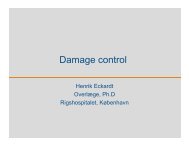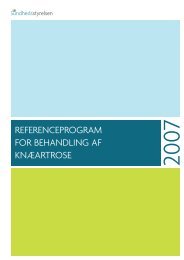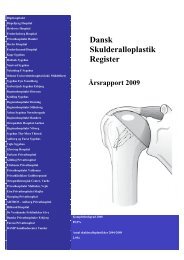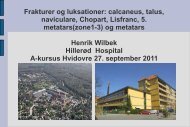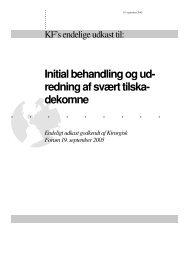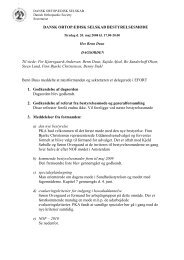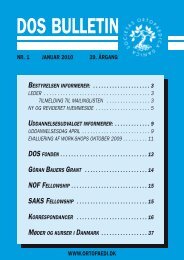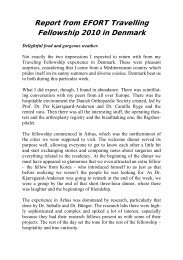DOS BULLETIN - Dansk Ortopædisk Selskab
DOS BULLETIN - Dansk Ortopædisk Selskab
DOS BULLETIN - Dansk Ortopædisk Selskab
You also want an ePaper? Increase the reach of your titles
YUMPU automatically turns print PDFs into web optimized ePapers that Google loves.
2010-378_<strong>DOS</strong> nr. 3 2010 29/09/10 10:08 Side 88<br />
MRI findings in childrens wrists after trauma.<br />
A pilot study<br />
Tine Jochewet Ravn Dimon, Pernille Wied Greisen, Jan Schultz Hansen<br />
OUH, Svenborg<br />
Background: Every day we see children in the emergency room with<br />
trauma of the wrist and distal radius. Standard x-ray findings are often<br />
found without fractures despite direct and indirect tenderness of the distal<br />
radius. No literature describing the MRI findings in this group of<br />
patients has been published.<br />
Purpose: Description of the pathology behind distal radius traumas in 7-<br />
13 years old children with no signs of fractures in conventional x-rays by<br />
the use of MRI- scan.<br />
Methods: A pilot study with 21 7-13 years old children was carried out.<br />
The median age was 12 years old. All children included in the study had<br />
a relevant trauma of the wrist or distale radius, as well as direct and indirect<br />
tenderness and no abnormal findings in standard X- rays. Within the<br />
first two days they were offered MRI-scan. Both coronal and sagital T1<br />
recordings and coronal STIR was performed to the traumatized wrist.<br />
STIR/TIRM recordings were performed to the non-traumatizes wrist. In<br />
this manner the non-traumatized wrist functioned as control group.<br />
Findings: All children had normal MRI findings of their non traumatized<br />
controlwrist. 7 children had no abnormalities in the traumatized<br />
wrist. 3 children had undislocated fractures of the distal radius. 3 children<br />
had undislocated os scaphoid fractures. 3 children had oedema of<br />
the distal radius 3 children had oedema of os capitatum or trapezium and<br />
2 had soft tissue oedema.<br />
Conclusion: This pilot study shows that 6/ 21 children had unrecognized<br />
fractures. Another 6/21 had bone oedema and 2/21 soft tissue oedema. It<br />
seems surprising that more than half of the children in this pilot group<br />
that would otherwise be diagnosed with no abnormalities have got bone<br />
affections. We don’t know the clinical consequences of these findings.<br />
Do they have any relevance at all? Are these the same children that<br />
develop chronic wrist pains? Would the MRI- findings be the same in<br />
other bones? And is MRI the golden standard of diagnosing clinical relevant<br />
fractures in children at all? Further studies in the field seem necessary.<br />
88



